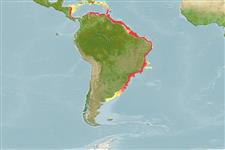Common names from other countries
>
Eupercaria/misc (Various families in series Eupercaria) >
Sciaenidae (Drums or croakers)
Etymology: Cynoscion: Greek, kyon = dog + Greek, odous = teeth + Greek, skion, skiaina = barbel, red mullet (Ref. 45335).
More on authors: Vaillant & Bocourt.
Environment: milieu / climate zone / depth range / distribution range
экология
морской; солоноватоводный демерсальный; пределы глубины 1 - 70 m (Ref. 9626), usually 18 - 55 m (Ref. 9626). Subtropical; 18°N - 52°S, 83°W - 34°W
Western Atlantic: Panama and the Greater Antilles to Argentina. Including Lesser Antilles (Ref. 26938). Also reported in Nicaragua (Ref. 13613).
Length at first maturity / Size / Вес / Возраст
Maturity: Lm 25.1, range 15 - ? cm
Max length : 56.9 cm TL самец/пол неопределен; (Ref. 125970); common length : 35.0 cm TL самец/пол неопределен; (Ref. 3702); наибольший вес (опубликованные данные): 2.2 kg (Ref. 125970)
колючие лучи спинного плавника (общее число) : 11; членистые (мягкие) лучи спинного плавника (общее число) : 23 - 27; колючие лучи анального плавника: 2; членистые (мягкие) лучи анального плавника: 9. Colour greyish above, silvery below. Without conspicuous spots, but with faint dark streaks along scale rows above lateral line. Pectoral-fin bases and upper rays slightly dark, pelvic and anal fins often yellowish, dorsal and caudal fins dusky with darker margin. Inside opercle darkish visible externally. Mouth large, oblique, lower jaw slightly projecting. Upper jaw with a pair of large canine-like teeth at tip. Chin without barbel or pores, snout with only 2 marginal pores. Gas bladder with a pair of horn-like anterior appendages. Sagitta (large earstone) moderately broad and thick, Lapillus (small earstone rudimentary. Scales large. Soft portion of dorsal-fin base covered with small scales up to 1/2 of fin height (Ref 51721).
Found over sand or mud bottoms from the coastline to about 60 m depth (Ref. 3702); rarely in waters with a depth of less than 18 m (Ref. 9626). Juveniles inhabit river estuaries (Ref. 3702). Oviparous, with high fecundity (Ref. 54358). Feed on fishes and crustaceans like crabs and shrimps (Ref. 35237). Important food fish (Ref. 3702).
Cervigón, F., 1993. Los peces marinos de Venezuela. Volume 2. Fundación Científica Los Roques, Caracas,Venezuela. 497 p. (Ref. 9626)
Статус Красного Списка МСОП (Ref. 130435)
CITES (Ref. 128078)
Not Evaluated
Угроза для людей
Harmless
Использование человеком
рыболовство: коммерческий; объект спортивного рыболовства: да
дополнительная информация
инструменты
Специальные отчеты
Скачать в формате XML
ресурсы в Интернет
Estimates based on models
Preferred temperature (Ref.
115969): 11.3 - 27.9, mean 22.4 (based on 376 cells).
Phylogenetic diversity index (Ref.
82804): PD
50 = 0.5000 [Uniqueness, from 0.5 = low to 2.0 = high].
Bayesian length-weight: a=0.00741 (0.00614 - 0.00895), b=3.07 (3.05 - 3.09), in cm Total Length, based on LWR estimates for this species (Ref.
93245).
Trophic level (Ref.
69278): 3.8 ±0.66 se; based on food items.
устойчивость к внешним воздействиям (Ref.
120179): высокий, минимальное время удвоения популяции до 15 месяцев (Fec = 47,000).
Prior r = 1.00, 95% CL = 0.66 - 1.50, Based on 1 data-limited stock assessment.
Fishing Vulnerability (Ref.
59153): Low to moderate vulnerability (32 of 100).
